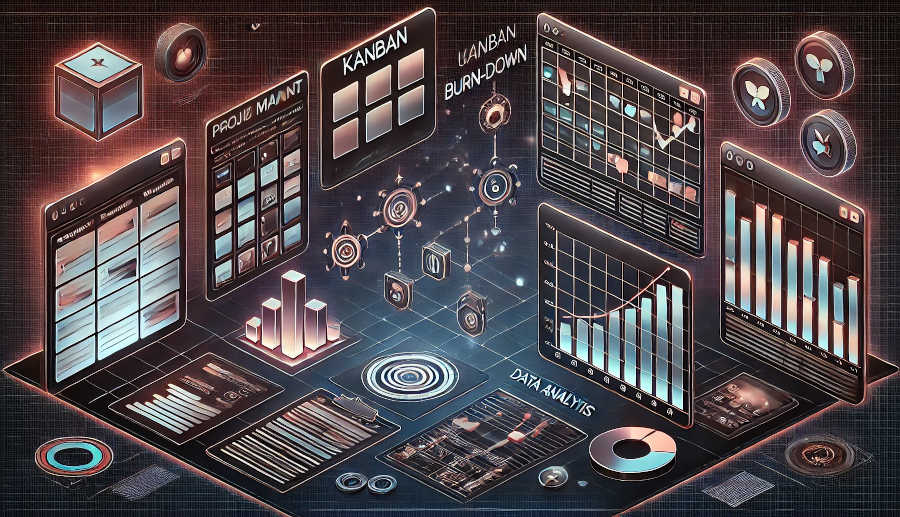Collaboration within a team is the cornerstone of success in project software development. In the realm of software projects, numerous tasks need to be coordinated seamlessly. From the initial concept design to the final deployment and maintenance, every stage involves different team members with diverse skills. For instance, developers need to work closely with designers to ensure that the software's functionality aligns with its visual appeal. Without effective collaboration, misunderstandings can occur, leading to delays, increased costs, and a subpar end product.
Moreover, in a software project, knowledge sharing is crucial. Team members bring different areas of expertise to the table. A junior developer might have fresh ideas about new programming techniques, while a senior member could have in-depth knowledge of the project's domain. By collaborating, they can exchange this knowledge, which enriches the overall development process. This not only helps in solving problems more efficiently but also in innovating and creating a more competitive software product.
Furthermore, collaboration in project software builds a sense of unity and shared purpose. When team members work together towards a common goal, they feel more engaged and motivated. This positive work environment can boost productivity and job satisfaction. In a software project where deadlines are often tight, a collaborative team can pull together and overcome challenges more effectively, ensuring that the project is completed on time and to a high standard.
Establishing Clear Communication Channels
Clear communication is the lifeblood of successful team collaboration in project software. First and foremost, it's essential to define the preferred communication tools. In today's digital age, there are numerous options available, such as instant messaging platforms, project management software with built-in communication features, and video conferencing tools. For example, Slack can be used for quick updates and informal discussions among team members, while Jira's communication features can be integrated with task management to keep everyone informed about the progress of specific tasks.
Secondly, setting up regular communication schedules is vital. Weekly team meetings can be used to discuss overall project progress, share any challenges faced, and plan for the upcoming week. These meetings provide a platform for everyone to voice their opinions and concerns. Additionally, daily stand-up meetings, lasting no more than 15 minutes, can be held to quickly update on the previous day's work and any immediate issues. This ensures that everyone is on the same page and any potential problems are addressed promptly.
Finally, it's important to establish a culture of open communication. Team members should feel comfortable sharing their ideas, even if they are unconventional. This includes being able to provide constructive feedback to colleagues. For example, if a developer notices a potential flaw in another's code, they should be able to communicate this in a respectful and helpful manner. By fostering an environment where open communication is encouraged, the team can work together more effectively to improve the software project.
Defining Roles and Responsibilities
In project software, clearly defining roles and responsibilities is fundamental to successful collaboration. Each team member should have a well-defined scope of work. For the development team, this could mean specifying which modules or features each developer is responsible for. This clarity helps in avoiding duplication of work and ensures that all aspects of the software are accounted for. For example, one developer might be in charge of the user authentication module, while another focuses on the database integration.
Moreover, understanding the dependencies between roles is crucial. A designer's work might depend on the requirements gathered by the product manager. Similarly, the testing team can only start their work once the developers have completed a certain stage of coding. By mapping out these dependencies, the team can better plan their work and avoid bottlenecks. This also helps in setting realistic deadlines for each task, as everyone is aware of the sequence in which work needs to be done.
Finally, having a clear chain of command and decision-making process is essential. In a software project, there will inevitably be situations where decisions need to be made quickly. Knowing who has the authority to make these decisions, whether it's the project manager, a lead developer, or a cross-functional team, ensures that the project doesn't get stalled. This clarity also helps in resolving conflicts and disputes within the team, as everyone knows the proper channels to follow.
Building Trust and Respect Among Team Members
Trust and respect are the foundation of a harmonious and productive team in project software. Building trust starts with being reliable. Team members should deliver on their commitments. If a developer promises to complete a task by a certain date, they should do everything in their power to meet that deadline. This consistency in performance builds trust among colleagues, as they know they can rely on each other to get the job done.

Respect, on the other hand, is about valuing each team member's opinions and contributions. In a software project, different people bring different perspectives. A marketing team member might have insights into user needs that the technical team might not consider. By respecting these diverse viewpoints, the team can make more informed decisions. This also creates an inclusive environment where everyone feels valued and motivated to contribute their best.
Furthermore, team-building activities can play a significant role in building trust and respect. These activities can range from simple lunchtime gatherings to more elaborate off-site retreats. Through these interactions, team members can get to know each other on a personal level, which helps in breaking down barriers and building stronger relationships. In a more relaxed setting, team members can share stories, hobbies, and interests, which in turn leads to a more positive and collaborative work environment.
Handling Conflicts and Disagreements
Conflicts and disagreements are inevitable in any project software team. The key is to handle them in a constructive manner. First, it's important to encourage team members to address conflicts directly. When a disagreement arises, instead of avoiding it or letting it fester, the parties involved should be encouraged to have an open and honest conversation. This could be in a one-on-one meeting or in a small group setting, depending on the nature of the conflict.
Secondly, focusing on the issue rather than the person is crucial. In a heated argument, it's easy to personalize the conflict. However, in a software project, the goal should be to find the best solution for the project. For example, if two developers have different opinions on the best programming approach for a particular feature, they should discuss the pros and cons of each method without attacking each other's abilities.
Finally, having a neutral mediator can be helpful in resolving complex conflicts. This could be the project manager or an experienced team member. The mediator can listen to both sides of the argument, ask clarifying questions, and help the team find a common ground. By following these steps, conflicts can be turned into opportunities for growth and improvement in the software project.
Leveraging Diversity for Innovation
In project software, team diversity can be a powerful driver of innovation. A diverse team brings together different backgrounds, cultures, and experiences. For example, a team that includes members from different countries might have different perspectives on user needs and market trends. This diversity of thought can lead to more creative solutions in software development. A developer from one culture might come up with a unique user interface design that appeals to a wider range of users.
Moreover, diverse teams can better understand and meet the needs of a global user base. In today's interconnected world, software is used by people from all over the globe. A team with members who have experience in different regions can ensure that the software is culturally sensitive and meets the specific requirements of various markets. This can give the software a competitive edge in the global marketplace.
Finally, leveraging diversity in a software project team can also lead to a more dynamic and engaging work environment. When team members with different backgrounds work together, they can learn from each other and expand their horizons. This cross-pollination of ideas can spark innovation and lead to the development of cutting-edge software products.
Conclusion
In conclusion, effective collaboration with team members in project software is a multi-faceted endeavor. Understanding the importance of collaboration sets the foundation for a successful project. Establishing clear communication channels ensures that information flows smoothly among team members, enabling them to coordinate their efforts effectively. Defining roles and responsibilities helps in streamlining the workflow and avoiding confusion. Building trust and respect among team members creates a positive and productive work environment where everyone feels valued and motivated.
Handling conflicts and disagreements in a constructive manner is essential for maintaining team harmony and moving the project forward. Leveraging diversity for innovation allows the team to tap into a wealth of ideas and perspectives, leading to the development of more competitive software products. By focusing on these aspects, project software teams can enhance their collaboration capabilities, improve productivity, and ultimately achieve success in their software development endeavors. It's a continuous process that requires commitment and effort from all team members, but the rewards in terms of high-quality software products and a fulfilling work experience are well worth it.
ARTICLE TITLE :How to collaborate with team members in Project software ,AUTHOR :ITpmlib

















